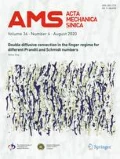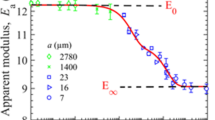Abstract
Viscoelasticity and poroelasticity commonly coexist as time-dependent behaviors in polymer gels. Engineering applications often require knowledge of both behaviors separated; however, few methods exist to decouple viscoelastic and poroelastic properties of gels. We propose a method capable of separating viscoelasticity and poroelasticity of gels in various mechanical tests. The viscoelastic characteristic time and the poroelastic diffusivity of a gel define an intrinsic material length scale of the gel. The experimental setup gives a sample length scale, over which the solvent migrates in the gel. By setting the sample length to be much larger or smaller than the material length, the viscoelasticity and poroelasticity of the gel will dominate at different time scales in a test. Therefore, the viscoelastic and poroelastic properties of the gel can be probed separately at different time scales of the test. We further validate the method by finite-element models and stress-relaxation experiments.

Similar content being viewed by others
References
Zwieniecki, M.A., Melcher, P.J., Holbrook, N.M.: Hydrogel control of xylem hydraulic resistance in plants. Science 291, 1059–1062 (2001)
Mow, V.C., Kuei, S.C., Lai, W.M., et al.: Biphasic creep and stress-relaxation of articular-cartilage in compression—heory and experiments. J. Biomech. Eng.-Trans. ASME 102, 73–84 (1980)
Liu, Z., Swaddiwudhipong, S., Hong, W.: Pattern formation in plants via instability theory of hydrogels. Soft Matter 9, 577–587 (2013)
Liu, Z., Hong, W., Suo, Z., et al.: Modeling and simulation of buckling of polymeric membrane thin film gel. Computational Materials Science 49, S60–S64 (2010)
Zhao, X., Kim, J., Cezar, C.A., et al.: Active scaffolds for ondemand drug and cell delivery. Proceedings of the National Academy of Sciences of the United States of America 108, 67–72 (2011)
Lee, K.Y., Mooney, D.J.: Hydrogels for tissue engineering. Chemical Reviews 101, 1869–1879 (2001)
Luo, Y., Shoichet, M.S.: A photolabile hydrogel for guided three-dimensional cell growth and migration. Nature materials 3, 249–253 (2004)
Richter, A., Paschew, G., Klatt, S., et al.: Review on hydrogelbased pH sensors and microsensors. Sensors 8, 561–581 (2008)
Gerlach, G., Guenther, M., Sorber, J., et al.: Chemical and pH sensors based on the swelling behavior of hydrogels. Sensors and Actuators B: Chemical 111, 555–561 (2005)
Suo, Z.: Theory of dielectric elastomers. Acta Mechanica Solida Sinica 23, 549–578 (2010)
Beebe, D.J., Moore, J.S., Bauer, J.M., et al.: Functional hydrogel structures for autonomous flow control inside microfluidic channels. Nature 404, 588–590 (2000)
He, T., Li, M., Zhou, J.: Modeling deformation and contacts of pH sensitive hydrogels for microfluidic flow control. Soft Matter 8, 3083–3089 (2012)
Cai, S., Lou, Y., Ganguly, P., et al.: Force generated by a swelling elastomer subject to constraint. Journal of Applied Physics 107, 103535 (2010)
Barbut, S., Foegeding, E.A.: Ca2+-Induced gelation of preheated whey-protein isolate. J. Food Sci. 58, 867–871 (1993)
Hong, W., Zhao, X., Zhou, J., et al.: A theory of coupled diffusion and large deformation in polymeric gels. Journal of the Mechanics and Physics of Solids 56, 1779–1793 (2008)
Yoon, J., Cai, S., Suo, Z., et al.: Poroelastic swelling kinetics of thin hydrogel layers: Comparison of theory and experiment. Soft Matter 6, 6004–6012 (2010)
Li, Y., Tanaka, T.: Kinetics of swelling and shrinking of gels. The Journal of Chemical Physics 92, 1365–1371 (1990)
Quesada-Péez, M., Maroto-Centeno, J.A., Forcada, J., et al.: Gel swelling theories: The classical formalism and recent approaches. Soft Matter 7, 10536–10547 (2011)
Cai, S., Suo, Z.: Equations of state for ideal elastomeric gels. EPL (Europhysics Letters) 97, 34009 (2012)
Hong, W., Liu, Z., Suo, Z.: Inhomogeneous swelling of a gel in equilibrium with a solvent and mechanical load. International Journal of Solids and Structures 46, 3282–3289 (2009)
Kang, M.K., Huang, R.: A variational approach and finite element implementation for swelling of polymeric hydrogels under geometric constraints. Journal of Applied Mechanics 77, 061004 (2010)
Zhang, J., Zhao, X., Suo, Z., et al.: A finite element method for transient analysis of concurrent large deformation and mass transport in gels. Journal of Applied Physics 105, 093522 (2009)
Zhou, J., Huang, G., Li, M., et al.: Stress evolution in a phaseseparating polymeric gel. Modelling and Simulation in Materials Science and Engineering 18, 025002 (2010)
Ferry, J.D.: Viscoelastic Properties of Polymers. John Wiley & Sons, Inc., New York (1980)
Zhao, X., Huebsch, N., Mooney, D.J., et al.: Stress-relaxation behavior in gels with ionic and covalent crosslinks. Journal of Applied Physics 107, 063509 (2010)
Chen, D.T., Wen, Q., Janmey, P.A., et al.: Rheology of soft materials. Annual Review of Condensed Matter Physics 1, 301–322 (2010)
Cai, S., Hu, Y., Zhao, X., et al.: Poroelasticity of a covalently crosslinked alginate hydrogel under compression. Journal of Applied Physics 108, 113514 (2010)
Hu, Y., Chan, E.P., Vlassak, J.J., et al.: Poroelastic relaxation indentation of thin layers of gels. Journal of Applied Physics 110, 086103 (2011)
Hu, Y., You, J.O., Auguste, D.T., et al.: Indentation: A simple, nondestructive method for characterizing the mechanical and transport properties of pH-sensitive hydrogels. J. Mater. Res. 27, 152–160 (2012)
Hu, Y., Chen, X., Whitesides, G.M., et al.: Indentation of polydimethylsiloxane submerged in organic solvents. J.Mater. Res. 26, 785–795 (2011)
Kalcioglu, Z.I., Mahmoodian, R., Hu, Y., et al.: From macro-to microscale poroelastic characterization of polymeric hydrogels via indentation. Soft Matter 8, 3393–3398 (2012)
Strange, D.G., Fletcher, T.L., Tonsomboon, K., et al.: Separating poroviscoelastic deformation mechanisms in hydrogels. Appl. Phys. Lett. 102, 031913 (2013)
Hyland, L.L., Taraban, M.B., Feng, Y., et al.: Viscoelastic properties and nanoscale structures of composite oligopeptidepolysaccharide hydrogels. Biopolymers 97, 177–188 (2012)
Olberding, J.E., Francis Suh, J.: A dual optimization method for the material parameter identification of a biphasic poroviscoelastic hydrogel: Potential application to hypercompliant soft tissues. J. Biomech. 39, 2468–2475 (2006)
Cheng, L., Xia, X., Scriven, L.E., et al.: Spherical-tip indentation of viscoelastic material. Mech. Mater. 37, 213–226 (2005)
Constantinides, G., Kalcioglu, Z.I., McFarland, M., et al.: Probing mechanical properties of fully hydrated gels and biological tissues. J. Biomech. 41, 3285–3289 (2008)
Ebenstein, D.M., Pruitt, L.A.: Nanoindentation of soft hydrated materials for application to vascular tissues. J. Biomed. Mater. Res. Part A 69A, 222–232 (2004)
Galli, M., Oyen, M.L.: Fast identification of poroelastic parameters from indentation tests. CMES-Comp. Model. Eng. Sci. 48, 241–269 (2009)
Hui, C.Y., Muralidharan, V.: Gel mechanics: A comparison of the theories of Biot and Tanaka, Hocker, and Benedek. J. Chem. Phys. 123, 154905 (2005)
Kaufman, J.D., Miller, G.J., Morgan, E.F., et al.: Timedependent mechanical characterization of poly(2-hydroxyethyl methacrylate) hydrogels using nanoindentation and unconfined compression. J. Mater. Res. 23, 1472–1481 (2008)
Lin, Y.Y., Hu, B.W.: Load relaxation of a flat rigid circular indenter on a gel half space. J. Non-Cryst. Solids 352, 4034–4040 (2006)
Oyen, M.L.: Poroelastic nanoindentation responses of hydrated bone. J. Mater. Res. 23, 1307–1314 (2008)
Hui, C.Y., Lin, Y.Y., Chuang, F.C., et al.: A contact mechanics method for characterizing the elastic properties and permeability of gels. J. Polym. Sci. Pt. B-Polym. Phys. 44, 359–370 (2006)
Hu, Y.H., Zhao, X.H., Vlassak, J.J., et al.: Using indentation to characterize the poroelasticity of gels. Appl. Phys. Lett. 96, 121904 (2010)
Galli, M., Comley, K.S.C., Shean, T.A.V., et al.: Viscoelastic and poroelastic mechanical characterization of hydrated gels. J. Mater. Res. 24, 973–979 (2009)
Galli, M., Fornasiere, E., Cugnoni, J., et al.: Poroviscoelastic characterization of particle-reinforced gelatin gels using indentation and homogenization. Journal of the Mechanical Behavior of Biomedical Materials 4, 610–617 (2011)
Chiravarambath, S., Simha, N.K., Namani, R., et al.: Poroviscoelastic cartilage properties in the mouse from indentation. Journal of biomechanical engineering 131, 011004 (2009)
Li, J., Hu, Y., Vlassak, J.J., et al.: Experimental determination of equations of state for ideal elastomeric gels. Soft Matter 8, 8121–8128 (2012)
Liu, Y., Chan-Park, M.B.: Hydrogel based on interpenetrating polymer networks of dextran and gelatin for vascular tissue engineering. Biomaterials 30, 196–207 (2009)
Hui, C., Feng, X., Jagota, A.: In situ measurement of the viscoelastic modulus of gels using pure twist-theory. Soft Matter 9, 913–920 (2013)
Wang, X., Hong, W.: A visco-poroelastic theory for polymeric gels. Proceedings of the Royal Society A:Mathematical, Physical and Engineering Science 468, 3824–3841 (2012)
Hu, Y., Suo, Z.: Viscoelasticity and poroelasticity in elastomeric gels. Acta Mechanica Solida Sinica 25, 441–458 (2012)
Biot, M.: Theory of deformation of a porous viscoelastic anisotropic solid. Journal of Applied Physics 27, 459–467 (1956)
Weitsman, Y.: Stress assisted diffusion in elastic and viscoelastic materials. Journal of the Mechanics and Physics of Solids 35, 73–94 (1987)
Weitsman, Y.: A continuum diffusion model for viscoelastic materials. Journal of Physical Chemistry 94, 961–968 (1990)
Govindjee, S., Simo, J.C.: Coupled stress-diffusion: Case II. Journal of the Mechanics and Physics of Solids 41, 863–887 (1993)
McBride, A.T., Bargmann, S., Steinmann, P.: Geometrically nonlinear continuum thermomechanics coupled to diffusion: a framework for case II diffusion. Advances in Extended and Multifield Theories for Continua. Springer, 89–107 (2011)
Gong, J.P., Katsuyama, Y., Kurokawa, T., et al.: Doublenetwork hydrogels with extremely high mechanical strength. Advanced Materials 15, 1155–1158 (2003)
Zhao, X.H.: A theory for large deformation and damage of interpenetrating polymer networks. Journal of the Mechanics and Physics of Solids 60, 319–332 (2012)
Wang, X., Hong, W.: Pseudo-elasticity of a double network gel. Soft Matter 7, 8576–8581 (2011)
Sun, J.Y., Zhao, X., Illeperuma, W.R., et al.: Highly stretchable and tough hydrogels. Nature 489, 133–136 (2012)
An, Y., Solis, F.J., Jiang, H.: A thermodynamic model of physical gels. Journal of the Mechanics and Physics of Solids 58, 2083–2099 (2010)
Henderson, K.J., Zhou, T.C., Otim, K.J., et al.: Ionically cross-linked triblock copolymer hydrogels with high strength. Macromolecules 43, 6193–6201 (2010)
Hui, C.Y., Long, R.: A constitutive model for the large deformation of a self-healing gel. Soft Matter 8, 8209–8216 (2012)
Author information
Authors and Affiliations
Corresponding author
Rights and permissions
About this article
Cite this article
Wang, QM., Mohan, A.C., Oyen, M.L. et al. Separating viscoelasticity and poroelasticity of gels with different length and time scales. Acta Mech Sin 30, 20–27 (2014). https://doi.org/10.1007/s10409-014-0015-z
Received:
Revised:
Accepted:
Published:
Issue Date:
DOI: https://doi.org/10.1007/s10409-014-0015-z




